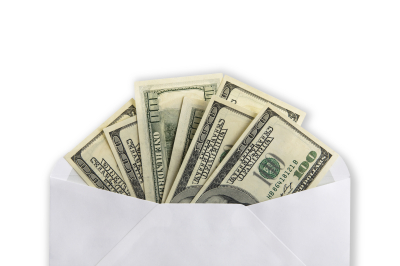 A couple of weeks ago when we discussed some of the pitfalls of credit cards, one of the suggestions made was to use the cash envelope system for buying groceries (and other essential items) instead. For those among us who need to relief of ditching the plastic, but who may be wary of the process, understanding the way that the cash envelope system works, and why it’s such a money-saver, is a great way to start.
A couple of weeks ago when we discussed some of the pitfalls of credit cards, one of the suggestions made was to use the cash envelope system for buying groceries (and other essential items) instead. For those among us who need to relief of ditching the plastic, but who may be wary of the process, understanding the way that the cash envelope system works, and why it’s such a money-saver, is a great way to start.
How Cash Envelopes Work
The name says it all: when you shop using the cash envelope system you designate a specific amount of cold, hard cash to each budgeting category on a biweekly or monthly basis (depending on pay cycles) and put it in an envelope. Generally, people start with a few, key budget-busting categories such as groceries, eating out, entertainment, and fun money. To make the cash envelope system work, you must decide, based on your overall budget, how much to designate for each category. For the sake of simplicity, I will use whole numbers that I completely made up for a fictional family of four:
- Groceries & Household Supplies: $500/month
- Dining Out: $100/month
- Entertainment & Parties: $100/month
- “Fun” Money: $100/month ($30 each for parents, $20 each for children)
Using this system and these numbers, you need $800 of cash each month. Depending on your financial flexibility, you can take it all out at once, at the beginning of the month, or at two $400 intervals in accordance with your pay cycle.
Once you have the money, take it and put it in actual envelopes. You can either make your own, buy simple but durable plastic pencil cases, or even get fancy fabric ones from craft vendors. The only exception to this is the “Fun” money category which many people just place directly in their wallets.
Now, here’s the tricky part: every time you go shopping or plan to purchase something in these categories, take the envelope and use it to pay – only. When the money runs out, you are done making purchases. When it comes to groceries and other common household purchases, this is one of the key benefits to having stock items and taking advantage of free and nearly-free deals with coupons – it helps make ends meet when the envelopes get empty. Catalina printouts are as good as cash as well, so you can use them to pick up small “must-have” items if you save them over time (just be aware of expiration dates!)
At the end of the month, take stock of how much cash is left in each envelope. Anything left over can either roll over into the next month or go into a separate savings account for special purchases such as a new television for the living room or a vacation fund.
Why Cash Envelopes Work
It is easy to apply the cash envelope theory to any area of your budget, but many people find it most helpful in areas prone to causing problems. There is no limit or rules as to what categories you can designate for your envelopes and many people include things like clothing, gas, or larger household purchases such as décor. Basically, whatever items in your personal budget cause you problems, switch them to cash.
But why, you ask?
There are many reasons that the cash envelope system works. First and foremost, many people find that parting with cash is a lot more difficult that the often-automatic action of swiping a card. Even when using a debit card (which is equivalent to cash), many people tend to ignore the totals or details of their purchases.
In addition, even debit cards offer buyers some form of overdraft protection meaning that, even if you don’t have the money, you can still make the purchase. This isn’t so with cash envelopes. Rather, when the envelope is empty, so is your spending power. You may need to get creative in terms of your entertainment or your lunch choices in order to make the system work until you refill the envelope next month. This act of forcing accountability is often really helpful in terms of getting people on track budget-wise.
Finally, a lot of people who have successfully converted to the cash envelope system find it more freeing that restricting. Remember, every month you decide how much money to spend and where. If you want new clothes, you budget for it. If you want to go to the spa, you budget for it. Rather than leaving charges to chance, you are able to indulge in your favorite pastimes while maintaining control, and peace of mind, over your purchases and financial health.
Who among you uses cash envelopes? What tips would you provide for beginners? What has been the biggest benefit of this system in your life?
